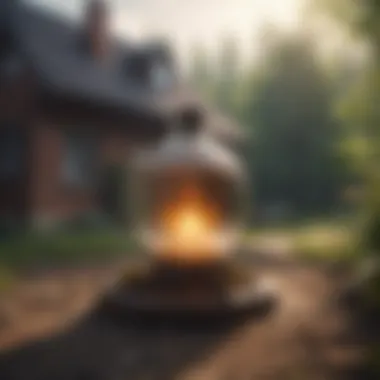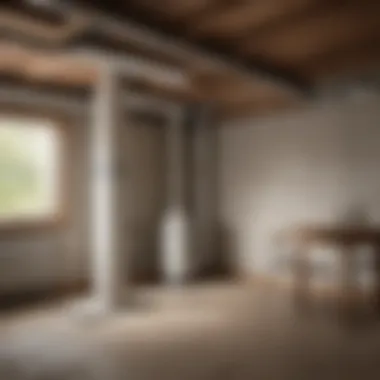Understanding Radon Levels in Homes and Health Risks


Intro
Radon is a naturally occurring radioactive gas that poses serious health risks to those exposed over long periods. It is colorless, odorless, and tasteless, making it difficult to detect without proper testing. Radon levels in homes can vary significantly based on geographical location, building materials, and even the layout of the home itself. Understanding radon and its implications is crucial for homeowners, particularly those in areas known for high radon concentrations.
In this article, we delve into radon's nature, its average levels in residential settings, and the potential health effects of long-term exposure. We also explore various radon testing methods and strategies for reducing radon levels. By offering insights tailored to the needs of students, researchers, and professionals, this article aims to foster a deeper understanding of radon and its impact on home safety.
Research Overview
Summary of key findings
Radon levels vary widely across different regions. The United States Environmental Protection Agency reports that radon can be found in homes at varying concentrations. The average radon level in homes is about 1.3 picocuries per liter (pCi/L), but concentrations can reach much higher levels in certain areas. Some states, particularly those with high uranium deposits in the soil, have an increased prevalence of elevated radon levels. Studies show that nearly one in fifteen homes in the U.S. is estimated to have radon levels that exceed safe limits.
Importance of the research in its respective field
Understanding radon exposure is essential not only for homeowners but also for public health officials. Increased awareness can lead to better health outcomes and preventive actions. This knowledge can help mitigate risks related to lung cancer, the leading cause of cancer deaths in the United States. By focusing on radon levels, researchers can contribute to improved housing safety and public health initiatives.
Methodology
Description of the analytical methods used
Research into radon levels employs various methods, including direct radon measurement through detectors. Continuous radon monitors provide real-time data, while passive devices, such as charcoal canisters, collect samples for analysis in labs. These methods allow for a comprehensive assessment of radon concentrations in residential spaces.
Sampling criteria and data collection techniques
Data collection typically involves testing a representative sample of homes within a specific geographical area. Researchers often use factors like building type, age of the home, and soil composition to select homes for testing. Comprehensive data collection ensures that the findings accurately represent radon levels across different regions and housing types.
"An understanding of radon levels and their health impacts is vital for making informed choices about home safety." - Public Health Experts
Overall, comprehending radon levels is essential for homeowners and health professionals alike. The evidence suggests a clear link between radon exposure and health risks, highlighting the importance of regular testing and mitigation strategies.
Prelims to Radon
Understanding radon is crucial for homeowners and health professionals alike. This section aims to elucidate the characteristics of radon, its health implications, and why awareness of this gas is essential. The presence of radon in residential settings may elevate health risks, particularly lung cancer. Many homeowners may be unaware of the radon levels in their homes, making this a significant concern in ensuring a safe living environment.
Radon is a colorless, tasteless, and odorless gas that can accumulate indoors. It is produced naturally from the decay of uranium found in soil, rock, and water. According to the U.S. Environmental Protection Agency (EPA), radon is the second leading cause of lung cancer after smoking. Given these alarming statistics, it is paramount that we understand what radon is and how it forms.
By gaining knowledge on radon levels, homeowners can take proactive steps in testing and, if necessary, mitigating their radon exposure. This approach not only protects individuals but also fosters broader public health awareness. In this section, we delve further into the nature of radon and its origins.
Health Implications of Radon Exposure
Radon exposure poses serious health risks, making this topic critical to understand. Radon is a tasteless, odorless gas that seeps into homes mainly through the ground. Once inside, individuals may unknowingly inhale it. This makes awareness and action necessary, especially given the hidden nature of the danger. Knowing the health implications allows homeowners to take informed steps to protect themselves and their loved ones.
Radon as a Carcinogen
Radon is classified as a human carcinogen by several health organizations. It is the second leading cause of lung cancer in the United States, after smoking. The gas decays into radioactive particles that can get trapped in the lungs when inhaled. Over time, the damage caused to lung tissue can lead to cancer development.
Homeowners need to recognize that radon isn’t only a concern for smokers. In fact, non-smokers can also face significant risks. According to the World Health Organization, radon exposure accounts for 3-14% of lung cancer cases. This wide range reflects variations based on different environmental factors. Exposure to high radon levels increases the risk of lung cancer significantly, which underscores the importance of monitoring and mitigation efforts in homes.
Statistics on Lung Cancer Risk
Statistical data reinforces the need for awareness about radon. The U.S. Environmental Protection Agency estimates that nearly 21,000 lung cancer deaths occur each year due to radon exposure. This affirms that more than 1 out of 15 homes in the U.S. has elevated radon levels (above 4 picocuries per liter).


"Radon is a silent danger, often overlooked, yet it has grave consequences for lung health."
Some studies indicate that individuals exposed to radon levels between 4 and 8 picocuries per liter could see their lung cancer risk increase by about 60%. Conversely, those who smoke and are exposed to radon face even greater risks. Understanding these statistics empowers homeowners to act responsibly concerning radon testing and mitigation.
Awareness of the health implications of radon is paramount. It affects not only personal health but also public health, housing markets, and local communities. Without proper information and understanding, radon can remain an unaddressed risk, threatening respiratory health over time.
Average Radon Levels in Residential Settings
Understanding the average radon levels in residential settings is crucial. Knowledge about these levels informs homeowners of potential risks. Identifying radon concentrations helps in making informed decisions regarding safety. Given that radon is a colorless and odorless gas, regular assessment can prevent long-term health effects.
Defining Average Radon Levels
Average radon levels in homes are usually reported in picocuries per liter (pCi/L). This measurement signifies the amount of radon in the air. The United States Environmental Protection Agency (EPA) sets an action level of 4.0 pCi/L. Below this level, risks are relatively low. However, levels can vary significantly across different homes. This variance often necessitates testing in individual residences to ensure safety.
Regional Variations in Radon Levels
Radon levels vary geographically due to several factors. Geological composition plays an important role. Areas with granite, shale, or phosphate deposits often have higher concentrations. For example, homes in parts of Colorado or Pennsylvania frequently report elevated radon levels.
Local building practices and materials also influence radon prevalence. Homes built on slabs or with inadequate ventilation may trap radon. Air pressure differences between indoors and outdoors can cause radon to be drawn into homes, particularly in lower areas.
Understanding the Units of Measurement
Understanding how radon levels are measured is essential for homeowners. The measurement unit is picocuries per liter (pCi/L). One picocurie represents a minute amount of radioactivity. The higher the pCi/L reading, the greater the radon concentration is within the residence.
Testing kits can provide a snapshot of radon levels. Short-term tests last from two days to seven days, while long-term tests monitor levels for a minimum of 90 days. Homeowners can choose depending on their needs. Regular testing and understanding the data can aid in taking appropriate action to minimize radon exposure.
Regular testing is the most effective strategy for managing radon levels in homes. Research indicates that up to 1 in 15 homes in the U.S. contains elevated radon levels.
Factors Influencing Radon Levels in Homes
Understanding the factors that influence radon levels in homes is vital for effective risk assessment and management. Radon, a colorless and odorless gas, originates from the natural decay of uranium found in soil and rock. As a result, its concentration can vary significantly among different residences. This section focuses on three key aspects that shape radon levels: geological influences, construction practices, and ventilation and indoor air quality. By unraveling these elements, homeowners and professionals can take informed steps to monitor and mitigate potential radon risks.
Geological Influences
Geological conditions are among the most significant determinants of radon levels in residential environments. The concentration of radon gas primarily depends on the underlying geology of an area. Areas with high uranium content in the soil or rock formations, such as granite or shale, tend to exhibit higher radon levels. Also, the local topography can affect radon exposure. Homes built on hills or sloped areas might experience radon accumulation due to the natural airflow patterns and how the gas migrates from the ground. Therefore, understanding local geology is crucial. Homebuyers and owners should consider obtaining geological data or consulting with local environmental experts when evaluating radon risks in their homes.
Construction Practices
Construction methods play a pivotal role in determining how radon penetrates homes. Newer homes may incorporate designs that minimize radon entry, such as sealed foundations and adequate ventilation systems. Conversely, older constructions might have vulnerabilities, like unsealed crawl spaces or cracks in the basement walls or floors, allowing radon gas to easily infiltrate. Homeowners should conduct thorough assessments of their property to identify construction shortcomings that could elevate radon levels. The adoption of standards during construction that focus on radon-resistant techniques can substantially reduce the risk. In some regions, building codes require radon mitigation measures for new homes, which reflects the importance of construction practices in curbing radon exposure.
Ventilation and Indoor Air Quality
Ventilation affects radon levels significantly, influencing indoor air quality as well. Improved ventilation helps to dilute radon gas concentrations inside homes. Systems designed to facilitate air exchange, such as exhaust fans and fresh air intakes, play an important role in managing radon levels. Homeowners should also consider the occupancy patterns and lifestyle choices, as these influence how air circulates in a residence. Conditions like tight sealing of windows and doors can trap radon indoors, while appropriate ventilation can dissipate it. It's important to understand the interplay between ventilation and radon, ensuring that indoor air quality is maintained along with mitigating risk. Regular assessments of ventilation systems can be beneficial in keeping radon levels in check.
Key Takeaway: Geological factors, construction practices, and ventilation methods are significant in understanding radon levels. Addressing these elements can aid in risk reduction and ensure a safer living environment.
Testing for Radon in Homes
Testing for radon in homes is a crucial step for ensuring indoor air quality and safeguarding health. The potential risks associated with radon exposure, particularly the increased likelihood of lung cancer, highlight why regular testing is essential. Homeowners often underestimate the impact of radon, considering it an abstract fear rather than a tangible threat. However, understanding radon levels can lead to informed decisions, mitigation actions, and ultimately, a safer living environment.
Types of Radon Testing Methods
There are several methods available for testing radon levels in homes, broadly classified into two categories: short-term and long-term testing.


- Short-term Testing: This method typically lasts between two to 90 days. It is often used as a quick screening tool. Popular devices for short-term testing include:
- Charcoal canisters
- Plastic bubble detectors
- Continuous radon monitors
These tools are easy to use and readily available. They provide immediate insight into the radon levels within a specific timeframe, which can be especially useful for potential home buyers or during real estate transactions.
- Long-term Testing: This approach spans more than 90 days, offering a more comprehensive evaluation of radon levels. Examples include:
- Alpha track detectors
- Electret ion chamber detectors
Long-term tests are beneficial because they account for variations in radon levels due to seasonal changes and daily fluctuations, providing a more accurate assessment.
DIY Radon Testing Kits
For homeowners interested in understanding and mitigating radon risk, DIY radon testing kits represent a straightforward and cost-effective solution. These kits can be purchased from various home improvement stores or online platforms. Typically, the process involves:
- Choosing the Right Kit: Ensure that the selected kit is approved by the EPA or a similar authority.
- Following Instructions: Clear guidelines are usually provided. It often involves placing the detector in the lowest lived-in level of the home for a specified time.
- Sending for Analysis: After the collection period, samples are sent to a lab for analysis, and results may be returned via mail or online.
While DIY kits provide a good initial estimate, they may not capture all variability, and the accuracy can be questioned without following up with professional testing when high levels are detected.
Professional Radon Testing Services
Engaging professional radon testing services adds another layer of reliability. Trained professionals utilize specialized equipment that often provides more accurate results than DIY methods. Here are some key advantages of using professional services:
- Enhanced Accuracy: Professionals carry out extensive testing, often across multiple locations in the home, ensuring comprehensive data collection.
- Expert Interpretation: Experts can provide a thorough analysis and help outline the significance of the results in layman's terms.
- Mitigation Recommendations: After testing, they can suggest tailored mitigation strategies based on the severity of radon levels.
The expertise of radon professionals can significantly reduce the uncertainty homeowners face regarding their indoor air quality.
Mitigation Strategies for Radon
Mitigation strategies for radon are essential for ensuring the safety and health of individuals living in homes with elevated radon levels. Identifying and implementing effective methods to reduce these levels can significantly decrease the risk of long-term health issues, including lung cancer. Therefore, understanding various mitigation options is a key aspect of managing home safety. This section will break down the different strategies available, their effectiveness, and practical considerations for homeowners.
Understanding Radon Mitigation
Radon mitigation is the process of reducing radon gas concentrations in the indoor air of a building. Various techniques and systems are employed to achieve safer radon levels. The primary goal is to minimize radon ingress from the soil beneath, as this is the source of radon that accumulates in homes.
A few common methods of mitigation include:
- Sub-slab depressurization: This approach involves installing a vent pipe and fan system that creates a vacuum beneath the house, allowing radon to be expelled before it has a chance to enter.
- Drainage systems: These systems redirect water away from the foundation and help mitigate radon by lowering the moisture content in the soil, which in turn reduces radon levels.
- Sealing cracks and openings: This method is often paired with active systems to increase the overall effectiveness of radon mitigation. Sealing helps prevent radon from entering, but it does not address existing levels already present within the home.
Active vs. Passive Mitigation Systems
Mitigation systems can largely be classified into two categories: active and passive.
- Active Mitigation Systems: These systems utilize electrical fans to reduce radon levels actively. They continuously remove radon from beneath the house and expel it outdoors. Sub-slab depressurization is a common example of an active system.
- Passive Mitigation Systems: These systems rely on natural convection to move radon out of the home. This may involve vent pipes installed during construction, designed to allow radon gas to drift upwards and escape. While they are less effective than active systems, they still offer a reduction in radon levels without the need for electricity.
Homeowners should assess local conditions and their specific home designs to determine which option may be more suitable.
DIY Mitigation Options
For those looking to manage radon levels on their own, there are DIY mitigation options available. While these may not achieve the same level of effectiveness as professional systems, they can still help reduce radon concentrations to some extent.
Some practical DIY approaches include:


- Sealing cracks and gaps: Homeowners can inspect their homes for cracks in walls, floors, and around pipes and seals to minimize radon entry. Using appropriate sealants can help effectively seal these openings.
- Ventilation: Improving natural ventilation in the home by opening windows and using fans might reduce radon levels temporarily. However, this method’s effectiveness can vary based on climate conditions and may not be a long-term solution.
- Radon barriers: Installing protective membranes on the foundation or crawl space can act as a barrier against radon entry. This option may require some construction work and monitoring to assess its effectiveness.
It is important for homeowners to remember that while these DIY methods can be helpful, they might not be sufficient for homes with high radon concentrations. Consulting with professionals may be necessary to ensure effective mitigation.
By understanding these various mitigation strategies, homeowners can take informed action towards reducing radon levels in their residences and enhancing overall safety.
Regulations and Guidelines for Radon Levels
Understanding regulations and guidelines surrounding radon levels is crucial for homeowners and public health officials alike. These regulations not only serve to protect individuals from the potential dangers of radon exposure but also help in fostering an informed society. Given the recognized health risks associated with radon, especially lung cancer, compliance with established guidelines can bring significant benefits including safer living environments and a reduction in health-related costs. Moreover, these regulations encourage proactive measures amongst property owners, ultimately enhancing community awareness and responsibility.
Effective regulations can prove influential in mitigating risks associated with long-term radon exposure. They set the foundation for testing protocols, define acceptable radon levels, and provide frameworks for mitigation when required. The EPA (Environmental Protection Agency) in the United States sets specific guidelines that influence state regulations. It's essential for residents to familiarize themselves with these standards to ensure compliance and understand their rights and responsibilities under the law.
Ultimately, these regulations guide various stakeholders—homeowners, real estate professionals, and local authorities—toward achieving a common goal: making homes safer and healthier for everyone.
EPA Guidelines for Radon Levels
The EPA provides fundamental guidelines aimed at preventing radon exposure. These guidelines prescribe an action level of 4.0 picocuries per liter (pCi/L) for residential radon levels. If testing shows radon concentrations at or above this level, it is recommended that homeowners take steps for mitigation.
Key elements of the EPA guidelines include:
- Testing: The EPA emphasizes that all homes be tested for radon, particularly those in areas identified as high-risk zones.
- Mitigation: Homes with radon levels equal to or exceeding the action level should employ mitigation systems. These reduce radon levels effectively.
- Periodic Re-Testing: After mitigation, the EPA recommends re-testing homes periodically to ensure systems continue to function properly.
A well-implemented approach to these guidelines not only protects health but also maintains property values and confidence in the residential market. The EPA constantly reviews and updates these guidelines based on ongoing research, making it imperative for homeowners to stay informed.
International Standards for Radon Exposure
Different countries have set their own standards regarding radon exposure, reflecting varying regional conditions and policies. Understanding these international standards provides a broader context for addressing radon issues globally.
For instance, the World Health Organization suggests an action level of 100 Bq/m³ (approximately 2.7 pCi/L), which is lower than the EPA's standard. Various countries in Europe have developed their own guidelines:
- United Kingdom: The UK has a recommended action level of 200 Bq/m³ for homes and advises radon testing in affected regions.
- Canada: Canada sets an action level of 200 Bq/m³ and underscores the importance of radon reduction in residential settings.
- Germany: Germany employs a standard of 300 Bq/m³, where action is suggested if this level is exceeded.
The differences in international standards stress the importance of context when addressing radon exposure. Countries tailor their guidelines according to geological differences, historical data, and public health priorities. Collaborative research and knowledge-sharing among these entities may inform and enhance national strategies for radon awareness and mitigation.
Future Research Directions in Radon Studies
Radon research is an evolving field with broad implications for public health and safety. As new data emerges and technologies develop, understanding how radon behaves in our environment becomes increasingly vital. This section explores the significance of advancing research in radon studies, focusing on emerging technologies and public health initiatives that seek to mitigate the risks associated with radon exposure.
Emerging Technologies in Radon Detection
Innovations in technology are crucial for improving radon detection methods. Traditional radon testing typically relies on passive devices or laboratory analyses. Recent advancements, however, have brought forth new tools that offer continuous monitoring as well as real-time data analysis.
Key Technologies include:
- Digital Detectors: These devices utilize sensors that provide instant readings of radon levels. With wireless communication capabilities, users can receive alerts directly to their smartphones, ensuring that they are informed about potential hazards.
- Smart Home Integration: Many modern homes are equipped with smart technology. Integrating radon detectors into smart home systems allows homeowners to automate ventilation based on radon concentration levels, minimizing exposure.
- Geospatial Analysis: Emerging software can analyze geographical data to predict areas at increased risk of high radon levels, helping homeowners assess environmental hazards even before testing.
These advancements not only enhance detection accuracy but also encourage proactive measures to ensure safety indoors. Future research must prioritize these technologies to better equip homeowners to deal with radon exposure.
Public Health Initiatives
Current public health initiatives play a significant role in reducing radon exposure across communities. Efforts by organizations like the Environmental Protection Agency (EPA) focus on raising awareness and providing resources for effective testing and mitigation strategies.
Main Initiatives include:
- Educational Campaigns: Informative programs designed to increase public understanding of radon risks and the importance of home testing are essential. By highlighting statistics and guiding homeowners on how to test for radon, these campaigns effectively promote healthier living environments.
- Collaborations with Local Governments: Partnering with state and local agencies helps to form policies that encourage radon testing in newly constructed homes and during real estate transactions. This ensures that radon levels are considered early in the buying or building process.
- Funding for Research and Programs: Investment in research that explores effective mitigation methods and technologies is vital. Grants aimed at local organizations assist in spreading awareness and improving access to radon testing resources.
Public health initiatives are vital for protecting vulnerable populations, especially in regions identified as high-risk. Engaging community members in dialogue and empowering them with knowledge are essential steps toward reducing health risks associated with radon exposure.
To truly tackle the challenges posed by radon, collaboration between researchers, homeowners, and health officials is essential. Only by working together can we effectively manage this silent threat to our indoor environments.







